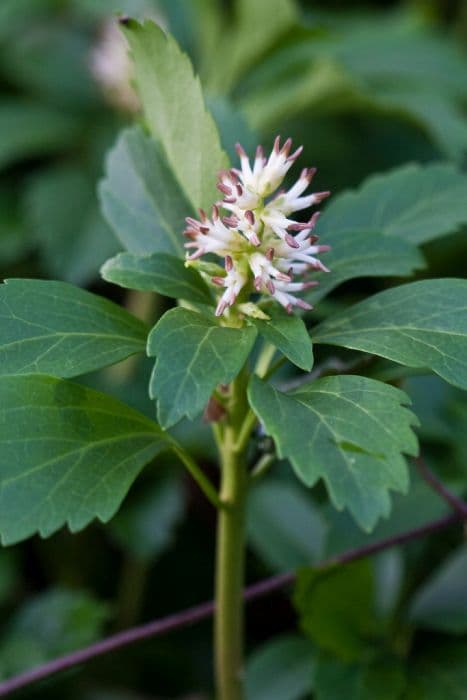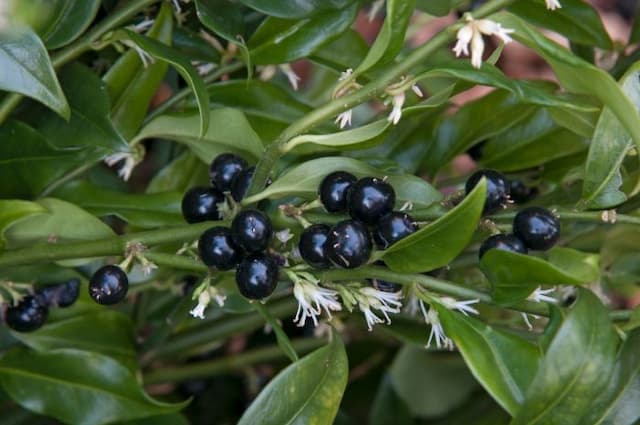Sweet Box Sarcococca hookeriana var. digyna

ABOUT
Sarcococca hookeriana var. digyna, commonly known as sweet box, is an evergreen shrub that is notable for its attractive and glossy deep green leaves, which are elongated with a slightly pointed tip. The leaves are arranged in an alternate fashion along the stems. Throughout late winter and early spring, this plant produces small, inconspicuous flowers that are highly fragrant. The blossoms are typically white to pale pink, and, despite their size, they emit a powerful and sweet scent that can fill the surrounding area. Following the flowering period, the plant may bear glossy, black berries, which provide visual interest and a contrast to the foliage. The structure of sweet box is dense and bushy, with multiple stems emerging from the base, creating a lush and full appearance. The overall impression of sweet box is of a neat, compact shrub that provides year-round interest with its evergreen leaves, fragrant winter flowers, and decorative berries.
About this plant
 Names
NamesFamily
Buxaceae
Synonyms
Purple-Stem Sarcococca, Himalayan Sweet Box
Common names
Sarcococca hookeriana var. digyna
 Toxicity
ToxicityTo humans
Sweet Box generally has a low level of toxicity to humans. If ingested, it may cause mild upset stomach or gastrointestinal discomfort, but it is not considered highly toxic. Eating large quantities could potentially lead to more severe symptoms, but generally, the plant is not considered dangerous to humans.
To pets
Sweet Box is also considered to have a low level of toxicity to pets. If pets consume parts of the plant, they might experience mild gastrointestinal upset, such as vomiting or diarrhea. However, severe toxicity is unlikely, and the plant is not typically known for being a serious danger to pets when ingested in small quantities.
 Characteristics
CharacteristicsLife cycle
Perennials
Foliage type
Evergreen
Color of leaves
Dark green
Flower color
White
Height
3-5 feet (0.91-1.52 meters)
Spread
3-5 feet (0.91-1.52 meters)
Plant type
Shrub
Hardiness zones
6
Native area
Himalayas
Benefits
 General Benefits
General Benefits- Aesthetic Appeal: Sarcococca hookeriana var. digyna, commonly known as Sweet Box, features attractive glossy green leaves and small white flowers that add beauty to garden landscapes.
- Fragrant Flowers: The flowers of Sweet Box emit a pleasing scent that can be enjoyed in the garden, particularly in winter when other plants are dormant.
- Shade Tolerance: Sweet Box is well-suited for shaded areas where other plants might not thrive, making it a useful choice for filling in dark corners of a garden.
- Low Maintenance: With its slow growth habit and minimal pruning requirements, Sweet Box is an excellent option for gardeners seeking low-maintenance plants.
- Drought Resistance: Once established, Sweet Box is relatively drought-tolerant, which is beneficial in regions with water restrictions or dry climates.
- Evergreen Foliage: As an evergreen plant, Sweet Box provides year-round interest and structure to the garden, even in colder months.
- Wildlife Support: The dense foliage offers shelter for wildlife, while its flowers can attract pollinators like bees during the blooming season.
- Erosion Control: Sweet Box’s root system can help stabilize soil on slopes or in areas prone to erosion.
- Versatility: Sweet Box can be used for a variety of landscape purposes, including as ground cover, in borders, or as a foundation planting.
 Medical Properties
Medical PropertiesThis plant is not used for medical purposes.
 Air-purifying Qualities
Air-purifying QualitiesThis plant is not specifically known for air purifying qualities.
 Other Uses
Other Uses- Sweet Box is used as a natural border or hedge in landscaping due to its dense foliage and slow growth habit, making it effective for creating privacy or defining areas within a garden.
- Given its tolerance for shade, Sweet Box can be planted under trees or in shadowed parts of the garden where other plants may struggle to grow.
- The plant's glossy evergreen leaves are sometimes included in floral arrangements, especially during the winter months for contrast and enduring freshness.
- Sweet Box is utilized in perfumery to capture its sweet fragrance, incorporating it into scents and potpourri to add a touch of springtime aroma to indoor spaces.
- The berries of Sweet Box, although inedible, can be used as natural decorations during the fall and winter, offering a pop of color in garden displays.
- Its robust root system can help with soil stabilization in sloped areas, preventing erosion and promoting soil health.
- The wood from Sweet Box can be used in small-scale woodworking projects, such as crafting decorative items, due to its fine grain and potential for a smooth finish.
- In winter gardens, Sweet Box serves as a vital source of nectar for bees and other pollinators when few other plants are in bloom.
- Some cultures use the fragrant Sweet Box in traditional ceremonies or for holiday decorations, appreciating its evergreen nature and pleasant aroma.
- As an educational tool, Sweet Box can be included in sensory gardens designed to engage visitors through smell and touch, demonstrating the variety of plant textures and scents.
Interesting Facts
 Feng Shui
Feng ShuiThe Sweet Box is not used in Feng Shui practice.
 Zodiac Sign Compitability
Zodiac Sign CompitabilityThe Sweet Box is not used in astrology practice.
 Plant Symbolism
Plant Symbolism- Endurance: Sarcococca, commonly known as Sweet Box, is an evergreen shrub that can withstand shade and poor soils, symbolizing the ability to endure challenging conditions.
- Fragrance: With its sweetly scented flowers, Sweet Box represents the spreading of delight and the power of subtle presence.
- Protection: It's often planted near homes or in gardens, where it serves as an evergreen barrier, symbolizing protection and security.
- Purity: The white color of its flowers is traditionally associated with purity and innocence.
- New Beginnings: Blooming in the cold months of late winter, Sweet Box can symbolize hope and the onset of new beginnings as it heralds the coming spring.
 Water
WaterSweetbox should be watered regularly, keeping the soil consistently moist but not waterlogged. During the growing season in spring and summer, it may need watering once or twice a week, depending on the weather conditions. Typically, an inch of water per week, either from rainfall or irrigation, is sufficient. In the fall and winter when the plant is dormant, reduce watering but do not allow the soil to completely dry out. If in a container, ensure it has adequate drainage to prevent root rot and adjust the watering accordingly to the pot size, usually around half a gallon per watering.
 Light
LightSweetbox thrives best in partial to full shade. It should be planted in a location that receives filtered sunlight or shade for the majority of the day, as too much direct sun can scorch the leaves. This makes it an ideal plant for understory conditions or north-facing sites where it will be protected from the harsh afternoon sun.
 Temperature
TemperatureSweetbox is cold hardy and performs well in a range of temperatures, thriving in temperatures between 60°F and 80°F. It can survive minimum temperatures down to around 0°F and it is suitable for growing in USDA Hardiness Zones 6 through 9. Sudden temperature fluctuations should be avoided to prevent stress to the plant.
 Pruning
PruningPrune Sweetbox to remove any dead or damaged branches and to maintain its shape. Pruning is best done in late winter or early spring before new growth starts but after the risk of severe cold has passed. Pruning can also be done after flowering to encourage bushier growth or to control the size. This plant does not require heavy pruning; a light trim every few years is generally enough.
 Cleaning
CleaningAs needed
 Soil
SoilSweet Box prefers moist, well-draining soil with a mix of two parts garden soil, one part leaf mold or compost, and one part perlite or sand. The ideal soil pH for Sweet Box should be slightly acidic to neutral, around pH 6.0 to 7.0.
 Repotting
RepottingSweet Box typically doesn't need frequent repotting and can thrive in the same pot for several years. Repotting once every 3-4 years is sufficient, or when the plant becomes root-bound.
 Humidity & Misting
Humidity & MistingSweet Box thrives in moderate to high humidity levels, making it well-suited for environments that mimic its native understory habitat. Aim to maintain humidity around 40-60% for optimal growth.
 Suitable locations
Suitable locationsIndoor
Keep Sweet Box in bright, indirect light with high humidity.
Outdoor
Plant Sweet Box in partial shade with shelter from wind.
Hardiness zone
6-9 USDA
 Life cycle
Life cycleSarcococca hookeriana var. digyna, commonly known as Sweet Box or Himalayan Sweet Box, begins its life cycle as a seed, often dispersed by birds that eat the attractive berries. Upon germination, the seedling emerges and develops into a young plant, establishing a root system and producing its first leaves. As it matures, Sweet Box develops into a dense, evergreen shrub with shiny, lanceolate leaves, typically reaching up to 5 feet in height. During late winter to early spring, it produces small, highly fragrant, white flowers, which are followed by the formation of black, shiny berries if pollination is successful. The plant continues to grow and spread slowly by suckering, forming clumps that create a lush ground cover. Over the years, with minimum maintenance, it can live for decades, being relatively pest-free and not typically subject to diseases.
 Propogation
PropogationPropogation time
Early spring
Sarcococca hookeriana var. digyna, commonly known as Sweet Box, is most effectively propagated through semi-hardwood cuttings. To propagate using this method, during the late summer, take semi-hardwood cuttings that are about 4 to 6 inches (10 to 15 centimeters) long. Choose a healthy, disease-free mother plant and make sure the cutting includes several leaf nodes. The bottom cut should be made just below a node as this area contains a high concentration of growth cells which can encourage root formation. Dip the cut end in rooting hormone to increase the chances of successful rooting. Then, plant the cutting in a pot containing a mix of peat and perlite or a sterile seed starting mix, ensuring at least one or two nodes are buried where roots can form. Keep the soil evenly moist and maintain high humidity around the cuttings, for example by covering the pot with a plastic bag. It can take several weeks for roots to develop. Once rooted, the new Sweet Box plants can be potted up individually and gradually hardened off before moving them to their final location in the garden.




